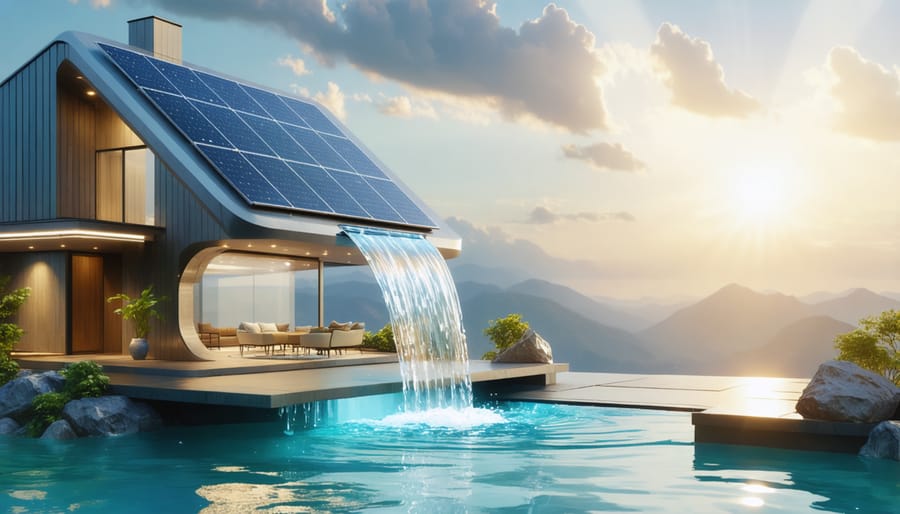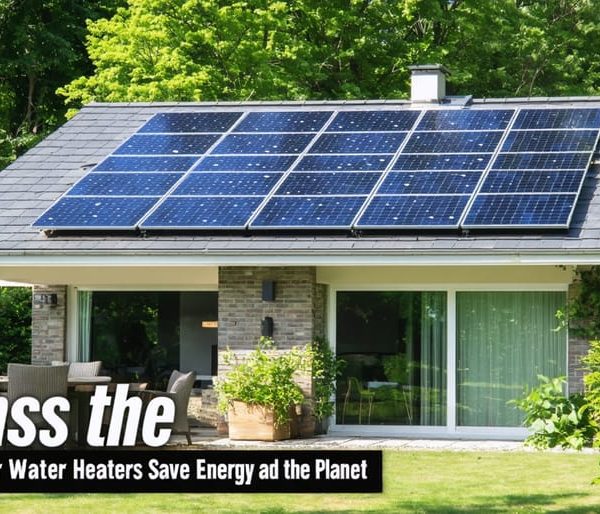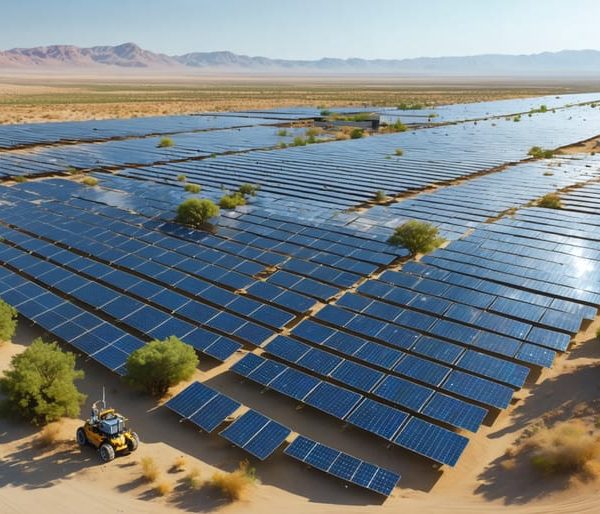Solar Water Generation: How Your Home Can Create Clean Water from Thin Air
Transform your property’s water management with solar-powered water purification systems that harness the sun’s energy to generate clean, sustainable water. This groundbreaking technology captures atmospheric moisture and converts it into potable water, producing up to 10 liters daily while eliminating dependence on traditional grid power.
Imagine drawing pure, filtered water directly from thin air using nothing but sunlight. That’s the revolutionary promise of solar water generation – a technology that’s reshaping how homes and businesses access clean water worldwide. By combining advanced hydropanel arrays with renewable solar energy, these systems create a renewable water source that operates independently of municipal infrastructure, even in remote locations.
For environmentally conscious property owners, solar water generation represents more than just a sustainable solution – it’s a practical answer to rising utility costs and water scarcity concerns. Whether you’re looking to reduce your carbon footprint, secure your water independence, or simply save on monthly bills, this innovative technology offers a compelling path forward.
How Solar Water Generation Works
The Science of Atmospheric Water Harvesting
The remarkable process of harnessing solar energy for water generation from the atmosphere relies on a fascinating natural phenomenon. When sunlight heats the air, water molecules become suspended as vapor, creating humidity. Solar water generators tap into this abundant resource using specially designed moisture-absorbing materials called desiccants.
These systems work by drawing air across these desiccants, which capture water molecules like a sponge. As the materials become saturated, solar heat is used to warm them, causing the trapped water vapor to be released. This vapor is then cooled and condensed into pure, liquid water – similar to how morning dew forms on grass.
The process is enhanced by solar-powered fans that increase airflow and improve efficiency. Advanced systems use photovoltaic panels to power additional components like UV purification systems and mineral filters, ensuring the water is safe to drink.
What makes this technology particularly exciting is its ability to work even in relatively dry conditions. While efficiency increases with higher humidity levels, most systems can produce water with as little as 20% relative humidity. This means they can operate effectively in many climates, making clean water accessible in areas where traditional water sources are scarce.
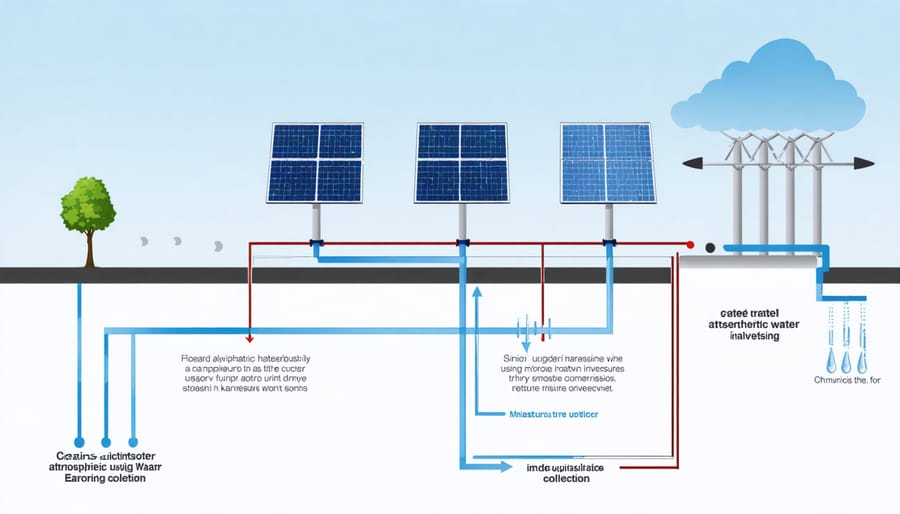
Components of a Solar Water Generator
A solar water generator consists of several essential components working together to transform sunlight into clean drinking water. At its heart is the solar panel array, which captures sunlight and converts it into electrical energy. These panels power the entire system and are typically mounted on the roof or in an area with maximum sun exposure.
The collection chamber is where the magic begins. This component draws in ambient air, which contains water vapor, through specialized filters that remove dust and contaminants. Next, the condensation unit uses the electricity from the solar panels to cool the air below its dew point, causing water vapor to condense into liquid form.
A key component is the filtration system, which includes multiple stages of purification. Water passes through activated carbon filters, removing odors and chemicals, followed by mineral filters that can add beneficial minerals back into the water. UV sterilization lights provide an additional layer of purification, eliminating harmful bacteria and viruses.
The storage tank keeps your generated water clean and ready for use. Most systems include monitoring sensors that track water quality, production rates, and system performance. A control panel ties everything together, managing the power distribution and allowing users to monitor and adjust settings as needed.
Finally, the distribution system includes food-grade pipes and dispensing points, ensuring your clean water is readily available when you need it.
Benefits for Homeowners
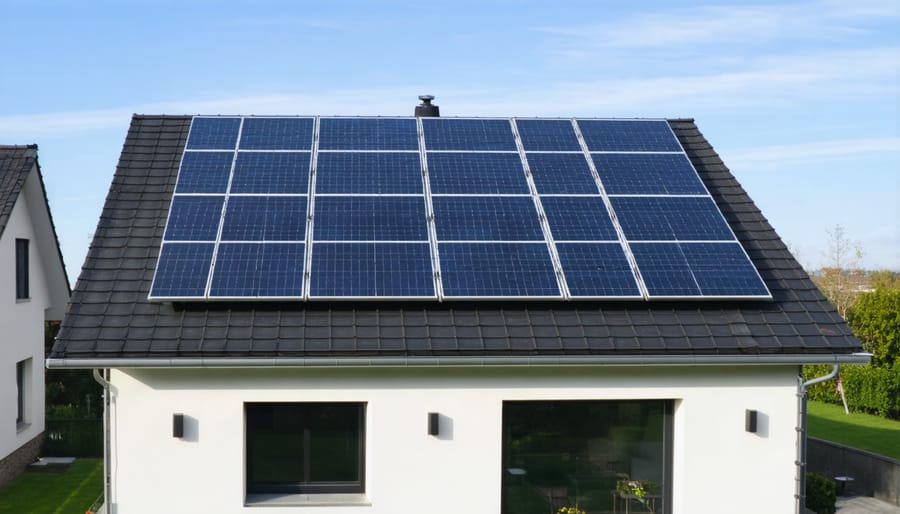
Energy and Cost Savings
Investing in solar water generation systems can lead to substantial savings on your utility bills while contributing to environmental conservation. Homeowners who implement these cost-effective solar solutions typically see a 40-60% reduction in their water heating costs within the first year of installation.
The initial investment in a solar water generation system usually ranges from $3,000 to $8,000, depending on system size and complexity. However, most homeowners recover these costs within 4-6 years through reduced utility bills. With systems lasting 20-25 years on average, you’ll enjoy over 15 years of virtually free water heating.
Federal tax incentives and local rebates can significantly reduce your upfront costs. Many states offer additional incentives, sometimes covering up to 30% of the installation costs. When combined with federal tax credits, these incentives can cut your initial investment by half.
Monthly savings vary by region and usage, but typical households save $50-$100 on their utility bills. Commercial properties often see even greater benefits, with some businesses reporting annual savings of $5,000 or more. Plus, as traditional energy costs continue to rise, your savings will likely increase over time, making solar water generation an increasingly valuable investment.
Environmental Impact
Solar water generation stands as a beacon of environmental sustainability in our fight against climate change. By harnessing the sun’s energy to extract water from air, this innovative technology significantly reduces the carbon footprint associated with traditional water sourcing methods. A single solar water generator can offset approximately 20,000 plastic water bottles annually, dramatically decreasing plastic waste and the associated environmental impact of bottled water production and transportation.
The system’s reliance on renewable solar energy means zero direct carbon emissions during operation. Unlike conventional water treatment plants or desalination facilities, solar water generators don’t require extensive infrastructure or energy-intensive processes. This translates to a reduction of up to 5 tons of CO2 emissions per year for a medium-sized installation.
Additionally, solar water generation promotes local water independence without depleting groundwater resources or straining existing water infrastructure. The technology’s minimal environmental impact extends to its installation footprint, requiring only a small area for setup and leaving surrounding ecosystems undisturbed.
The materials used in modern solar water generators are increasingly eco-friendly, with many manufacturers adopting recyclable components and sustainable production practices. Most systems have a lifespan of 15-20 years, making them a long-term sustainable solution for water generation. The maintenance process typically uses biodegradable cleaning products, ensuring minimal environmental impact throughout the system’s lifecycle.
Installation and Maintenance
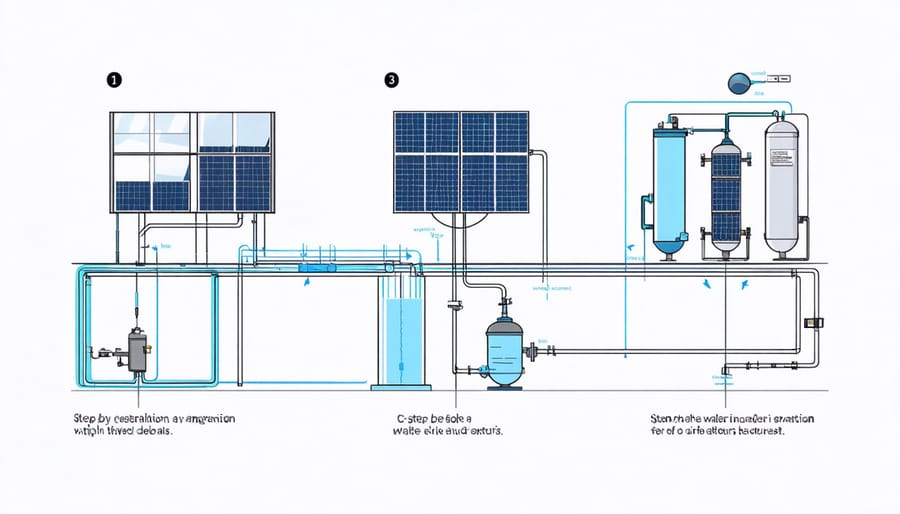
Setting Up Your System
Setting up your own home water generation systems is simpler than you might think. Start by choosing a suitable location that receives ample sunlight throughout the day, ideally on your roof or in an open yard space.
First, install the solar panels according to your system’s specifications. These should be mounted at a 30-45 degree angle facing south (in the Northern Hemisphere) to maximize sun exposure. Ensure the mounting structure is sturdy and weather-resistant.
Next, connect the water collection system. This typically includes:
1. A condensation chamber
2. Water storage tank
3. Filtration system
4. Distribution pipes
Install the condensation chamber directly below the solar panels. This is where atmospheric moisture will be captured and converted into clean water. Connect this to your storage tank using food-grade piping.
The filtration system should be installed between the condensation chamber and storage tank. This ensures your water meets drinking standards. Most systems come with built-in filters, but you may want to add mineral enrichment filters for better taste.
Set up the control panel in a protected area, connecting it to both the solar panels and your home’s electrical system as backup power. Install water quality sensors and monitoring devices to track system performance.
Finally, test the system thoroughly before regular use. Run it for 24-48 hours, checking water quality and system efficiency. Regular maintenance includes cleaning solar panels monthly and replacing filters as recommended by the manufacturer.
Maintenance Tips
Regular maintenance is key to keeping your solar water generation system running efficiently. Start by inspecting your solar panels monthly for dust, leaves, or debris that could reduce their effectiveness. A simple rinse with clean water during cooler hours is usually sufficient – avoid using harsh chemicals that might damage the panel surface.
Check your water storage tanks every three months for any signs of leakage, corrosion, or contamination. Clean the tanks annually using food-grade sanitizers and ensure all seals and connections remain tight. Monitor your filtration system monthly and replace filters according to the manufacturer’s recommendations – typically every 6-12 months depending on usage.
For hydropanel systems, inspect the fans and condensation chambers quarterly. Clean the air filters monthly to maintain optimal airflow and humidity collection. During winter months, pay special attention to any exposed pipes or components that might be vulnerable to freezing.
Common troubleshooting tips:
– If water production decreases, first check for blocked filters or dirty panels
– Strange noises often indicate fan issues or loose components
– Discolored water usually means it’s time to clean the storage tank or replace filters
– Low pressure could signal pump problems or clogged lines
Keep a maintenance log to track cleaning schedules and part replacements. This helps identify patterns and predict when components might need attention. For optimal performance, schedule a professional inspection annually to catch potential issues before they become problems.
Remember, preventive maintenance is always more cost-effective than emergency repairs. A well-maintained solar water generation system can provide clean water reliably for many years.
As we’ve explored throughout this article, solar water generation represents a groundbreaking solution to two of our most pressing challenges: sustainable water access and clean energy adoption. This innovative technology not only provides a reliable source of fresh water but does so while harnessing the abundant power of the sun, making it both environmentally responsible and cost-effective in the long run.
The benefits of solar water generation extend far beyond environmental conservation. Property owners who have embraced this technology report significant reductions in their utility bills, with many systems paying for themselves within just a few years. Moreover, the independence from traditional water sources provides invaluable security during water shortages or natural disasters.
What’s particularly exciting is the accessibility of this technology. Whether you’re a homeowner looking to reduce your environmental footprint or a business owner aiming to cut operational costs, solar water generation systems can be customized to meet your specific needs. The availability of different system sizes and configurations means there’s a solution for every situation and budget.
The testimonials we’ve shared from early adopters demonstrate the real-world impact of this technology. From desert homes now enjoying reliable water access to businesses reducing their carbon footprint while saving money, the success stories are both inspiring and practical.
As we look to the future, it’s clear that solar water generation will play an increasingly important role in sustainable living. With ongoing technological improvements and decreasing installation costs, there’s never been a better time to invest in this technology.
We encourage you to take the next step in your journey toward water independence and environmental stewardship. Consider scheduling a consultation with a certified installer to explore how solar water generation could benefit your property. By embracing this technology today, you’re not just investing in your property – you’re contributing to a more sustainable future for generations to come.
Remember, every drop of water generated through solar power is a step toward a cleaner, more sustainable planet. The future of water generation is here, and it’s powered by the sun.

